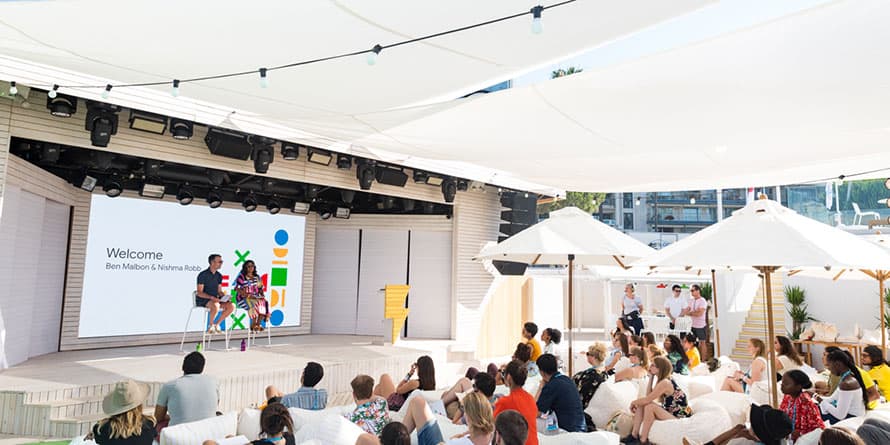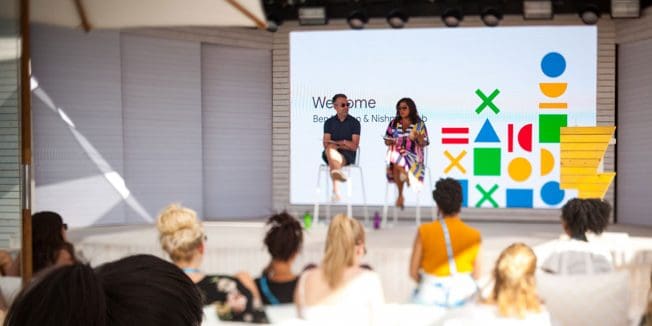It’s rare to hear a company take to task its past work, especially at the Cannes Lions Festival of Creativity. But that’s exactly what Google executives did during the kickoff breakfast for the company’s Creative Campus—a program designed to support 45 young creatives with different perspectives—touching on areas where the marketing was too hip or where the hiring process wasn’t working. The point? To show these newcomers that the company is changing, growing and expanding its creative approach while looking for people just like them to join their ranks.
“Actually, we were really tough on ourselves two or three years ago now, we realized that lots of the work we made was just reflective of the kind of hipster West Coast culture that many of the people who made the work lived in,” said Ben Malbon, senior director of marketing at Google. “In fact, it was partly due to the fact that many of the people who made the work were those people who were hipsters from the West Coast.”
He continued: “It made people inside Google feel like that’s cool but it didn’t really connect with the broad user base of all sorts of people from different backgrounds, different countries, different experiences. So, we set ourselves a goal of trying to improve the way we ourselves think about diversity as a kind of engine of creativity.”
To do that, the company had to not only examine its hip messaging but the way that messaging was put together, specifically who was putting it together. Steve Vranakis, executive creative director of Google’s Creative Lab in London, took a look at its internship program, the Google Five, and the way he had been hiring those interns.

“In the first few years of the Google Five I would literally get the portfolios sent to me and I’d look at the portfolios and I wouldn’t look at names or anything, I’d just look at books and judge the best work and ask the people who had the best work to come in for the internship,” said Vranakis. “Go figure, the majority of them were white men at the start of their career, the interns.”
He continued: “Then a couple years into it, this is going back several years, I had a couple of women on my team, Hannah and Janae, really help me with the program. We made a decision and a serious effort to stop just defaulting to what’s there and really starting to look elsewhere, starting to look outside of the industry, starting to look outside of all the conventional channels.”
Examining where and how the company was getting its applicants changed the program—and the work the program produced. “The direct impact that had on the work we were producing was incredible,” said Vranakis. “I was seeing the direct impact that diverse skills, diverse cultural reference points, diverse thinking, was bringing first hand to the work. It was actually creating much better work. For me, it was a joy to figure this out and I only wish I’d figured it out sooner.”
Vranakis is still working on the diversity of his team: “If I were to ask myself in areas like creative leadership, do I have enough women? I would say no. I’m still trying to get better at that.”

Google knows this isn’t going to be a quick fix, according to Nishma Robb, ads marketing director at Google, who noted that companies often have the “best intentions” to hire diverse candidates but when “rushing to fill a role” people revert to candidates like the ones they’ve hired before instead of taking the time to reach out to find truly diverse candidates.
“At the heart of it, great advertising and great creativity changes perceptions, changes the way the world thinks, the way we think about each other as well,” said Robb. “This isn’t just about reflecting diversity in our work or making sure it’s reflective in our products, that they are for everyone, but it’s actually about creating a greater sense of belonging, removing that sense of othering and making sure everyone has a sense that this world is for everyone.”

For the students attending the program, which Google developed in partnership with the festival, seeing a company like Google be transparent about the work needed to be more diverse was inspiring.
“I am very passionate about diversity in the creative industry because different ideas stem from different people,” said 22-year-old Alix Thomas of Cape May Court House, New Jersey. “As an African American woman, I believe it is very important to engage a diverse workplace as well as diverse content.”
For Thomas, who would like to use her talents to “enhance the aesthetics of a brand,” the Creative Campus was “extremely fulfilling and immersive. Google is such a trailblazer and to be a part of such a groundbreaking company and brand, I am very grateful. To be a part of the growth of diversity in the creative industry is amazing and I look forward to the future.”
Another attendee, 23-year-old Derrick Trotman of Denver, “It’s important to me to be a part of Google Creative Campus because I want to make a difference in Google’s diversity outreach. I want to learn from the senior members and what they want to change as the company moves forward and then be the change moving forward they are seeking.”

By creating the program, Google aimed to “help get more diversity in the grassroots of the creative industry,” explained Google CMO Lorraine Twohill. “But during the journey what we’ve learned is that we’re learning more than they are. [We went in] thinking we’re gonna help them but really they’re going to help us, they’re going to make us so much better.”
Twohill continued: “I hope we’ll hire a bunch of them. That’s my secret project—not so secret now.”











